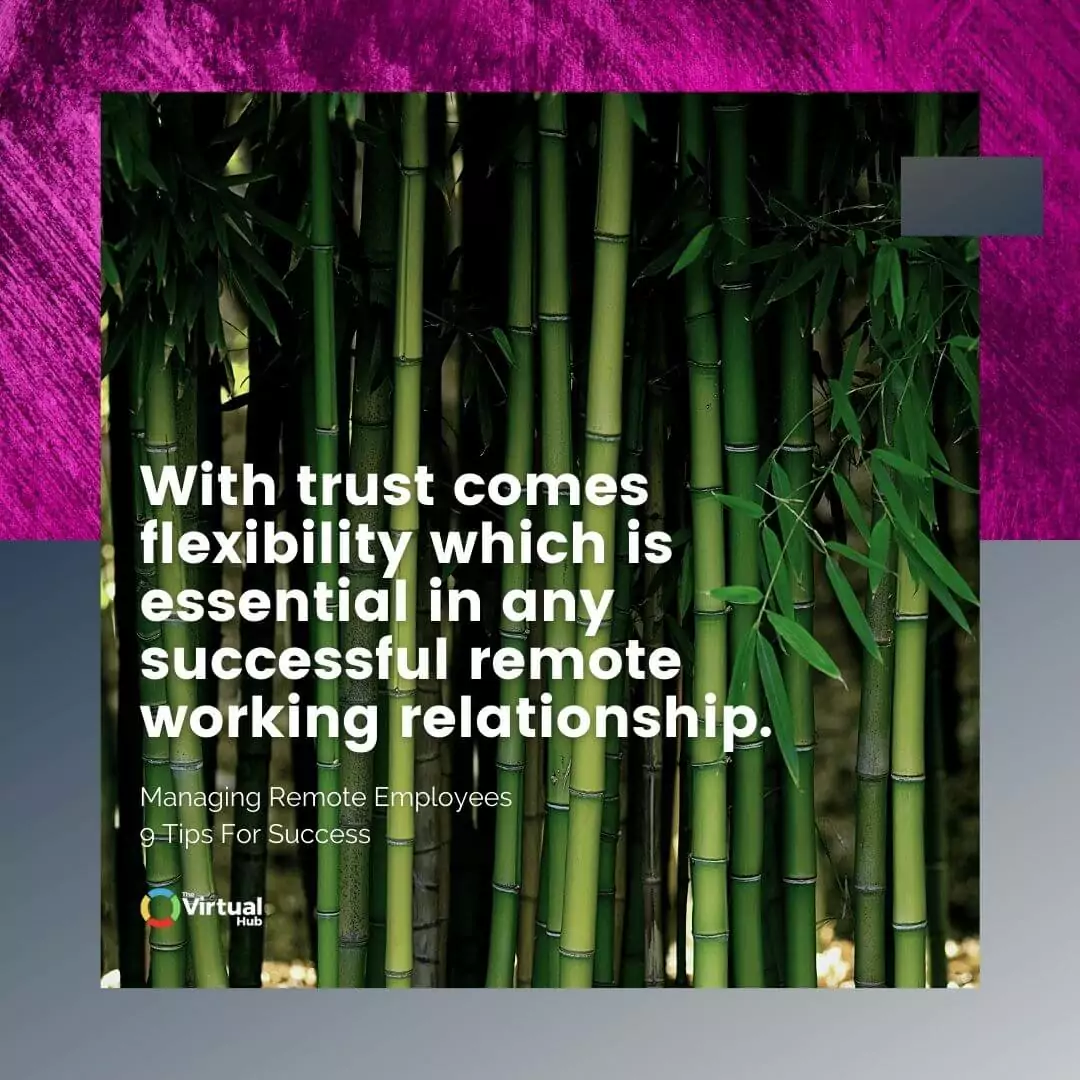As more and more businesses go remote, the need for effective management of remote employees becomes increasingly important. Here are nine tips for making sure your remote employees feel connected to your company and productive in their work.
RELATED: The Qualities Of A Good Leader In A Virtual Environment
How to Manage Remote Employees for Success
You can click on these links below to jump on a specific section:
- What Is Remote Work?
- What Are the Benefits of a Remote Workforce?
- What Are the Challenges of Managing Remote Teams?
- How Do You Know When Your Remote Employee Is Struggling?
- How Do You Create a Remote Work Policy That Works?
- What Are Some Tips for Managing Remote Employees?
- What Are Some Tools for Managing a Remote Team?
What Is Remote Work?
Remote work refers to an arrangement where employees are not required to report to a specific place to do their work.
Before the COVID-19 pandemic hit, there was already a steady rise in businesses that operated with remote teams. In fact, in 2019, business analysts predicted that approximately 70% of employees will work remotely for at least one week each month by 2025.

Work from home arrangements are even more popular these days with stay-at-home orders implemented across the world. So it’s more important than ever to invest in the skills and right tools you need to effectively manage remote workers.
What Are the Benefits of a Remote Workforce?
A remote workforce can offer a number of benefits for both employers and employees.
For employers, remote workers can help to reduce costs, such as rental for office space and electricity. Remote workers also tend to be more productive and take fewer sick days. And, since they are not tied to a specific location, employers can hire the best candidates from a larger talent pool, regardless of where they live.
For employees, working remotely can offer a number of advantages as well.
First, it can provide a better work-life balance. Many employees who work from home are often able to better manage their home life, and schedule their work around their personal commitments.
Second, working remotely can allow employees to escape the traditional office environment and create their own flexible schedules.
Additionally, working from home can give employees the opportunity to live and work in a location that is better suited to their lifestyle.
What Are the Challenges of Managing Remote Teams?
While there are many benefits to managing remote teams, there are also some challenges that come with it:
- Keeping track of everyone: It can be difficult to know what everyone is working on when you can't just pop into their office and ask.
- Ensuring job performance and productivity: When employees are working remotely, there is always the risk that they will take advantage of the situation and slack off.
- Maintaining team morale: It can be easy for team members to feel isolated when they're not in the same physical workspace.
- Lack of supervision: It can be difficult to provide the same level of supervision to remote employees as you would to employees in a traditional office setting.
How Do You Know When Your Remote Employee Is Struggling?
Here are a few tell-tale signs:
- If they suddenly stop communicating as much, it could be a sign that they're struggling. Maybe they're finding it hard to keep up with work, or perhaps they're feeling isolated and disconnected from the team. Either way, it's important to check in with them and see how they're doing.
- If their work starts to suffer in quality or quantity, or if they start missing deadlines, this is another sign that something might be up. Again, it's important to have a conversation with them to find out what's going on and see how you can help.
- If you notice any changes in their behavior--maybe they seem more withdrawn than usual, or more irritable--this could be an indication that something is wrong. This is definitely worth investigating further with a chat.
Of course, it's also important to remember that not everyone expresses themselves in the same way, so don't take these signs as gospel--if you have any concerns about an employee, always err on the side of caution and have a conversation with them. After all, open virtual communications are the key to a successful remote team!
How Do You Create a Remote Work Policy That Works?
Assuming you've already decided that you want to allow remote work at your company, there are a few key things to keep in mind when creating a policy:
Be Clear about What Is and Is Not Allowed
Will employees be allowed to work from home full-time, or only occasionally? What types of work can be done remotely? Will there be any exceptions?
Defining the parameters of the policy upfront will help avoid confusion later on
Think about How You Will Measure Productivity
Working from home can sometimes make it difficult to gauge how productive employees are. Make sure you have a system in place for tracking progress and ensuring that deadlines are being met. This could involve regular check-ins with managers, setting clear expectations for deliverables, or using a project management software.
Consider How You Will Provide Support to Remote Workers
As an employer, it's important to provide emotional support to your remote workers. One way to do this is to create opportunities for social interaction, such as scheduling regular video calls or holding monthly virtual happy hours.
You should also make sure that your remote employees have the resources they need to succeed, whether that means providing access to certain software or investing in a good pair of noise-cancelling headphones.
By showing that you care about your employees' well-being, you can create a positive and supportive virtual work environment.
What Are Some Tips for Managing Remote Employees?
1. Trust Your Employees

Remote setups won’t work if the manager can’t trust their employees to get the job done. Unlike regular workplaces, it’s very difficult to micromanage employees when they are working remotely.
On top of that, micromanagement can be a costly management style. Studies show that it can lower productivity and increase turnover.
If you can’t trust a team member to work without supervision, then remote work may not be the best setup for them.
With trust comes flexibility which is essential in any successful remote working relationship. It gives your employees the space to figure out how they’re going to meet their goals. Who knows, they may come up with something innovative!
Pro Tip: If you’re in the process of hiring remote workers, make sure you look for self-starters. These are people who are intrinsically motivated to get the job done even if they aren’t being supervised.

2. Establish Goals
In any kind of organization, it’s always important for managers to establish and communicate goals to their employees. Otherwise, it’ll be difficult for them to prioritize the right tasks and stay focused.

This is even more important for remote employees! Even if they’re working from home, remote employees need to understand the roles they play in the organization and how they contribute to the company’s long-term goals.
It’s also equally important to set clear and attainable short-term goals for all of your employees. That way, there won’t be any confusion when it comes to deliverables and deadlines.
Pro Tip: Clarity is essential when communicating goals to your team. Make sure your goals are well-defined, specific, and measurable.
3. Set Expectations

Goals will tell your employees what they need to achieve, but it’s just as important to establish clear expectations. Your expectations will provide your employees with parameters to work with.
Work expectations naturally differ in each organization, but they normally touch on the following issues:
- Work schedule: number of work hours employees are expected to render; depending on the agreement, employees can have a fixed or flexible work schedule
- Communication strategies: acceptable modes and channels of communication
- Group dynamics: the degree of interdependence in the workplace; some organizations value collaboration more than others
- Meeting norms: frequency and flow of team meetings
In a traditional office, many of these expectations are probably left unspoken. It’s easier to figure out a company culture when you’re actually there. But in a remote work environment, many things that usually go unsaid need to be made explicit.
RELATED: 4 Ways To Build A Positive Work Culture With Your Virtual Team

4. Adjust Communication Strategies
Lack of information and communication breakdown are a common problem among remote workers. That’s why managers need to adjust communication strategies when leading a remote workforce.

There are many non-verbal communication cues we take for granted. For instance, tone and hand gestures—without them, things can get lost in translation. It’s important to keep this in mind, especially when you’re giving feedback or constructive criticism.
Apart from these, a lot of productive discussions can take place during unofficial in-office chats. To make up for the lack of face-to-face interaction, try to maximize other communication channels.
Emails are standard in many businesses and organizations, but many users reserve emails for more official correspondences. Instant messaging is a great channel for quick follow-ups, daily check-ins, or simple questions.

Video conferencing is also a great way to encourage social interaction. When cameras are turned on, it’s easier to make a connection with your team.
When all else fails, don’t forget the offline route! Sometimes, old-fashioned phone calls can still do the trick!
Keep in mind that communication goes both ways—you need to know how to reach them and they need to know how to reach you.
5. Keep Track of Progress
As a manager, it’s important to keep track of your team’s progress.
When you’re working in an office, it’s easy to get updates from your employees. You can easily visit them in their work area to check in.
This can take up a lot of your time if you’re managing remote workers (especially if you’re handling a large team). Thankfully, there’s a tech solution for this too!

There are a variety of project management tools that you can use. Project management software can help you organize multiple projects involving different employees.
At a glance, you can see the progress of each project. It makes it easier to identify employees or teams who need more support.

6. Schedule One-On-One Calls
Conference calls are a great way to foster positive relationships among remote team members. But it’s important to set aside some one-on-one time with your employees as well.
Some people aren’t comfortable sharing their thoughts and ideas in a large group setting. Others also report that employee engagement dwindles during large virtual meetings because of video fatigue.

It’s a good practice to schedule regular meetings with your employees. Here are some things you can cover in these meetings:
- Get updates about projects/tasks
- Provide positive and constructive feedback
- Inquire about challenges
- Coaching/mentoring
- Ask about the employee’s well-being
A one-on-one meeting is also an opportunity for a remote worker to consult you about important issues. Try to have these one-on-one meetings regularly, so that your employees know they can count on it.
Pro Tip: If there’s nothing serious or work-related to talk about, use the meeting as an opportunity for small talk! It’s a great way to build rapport.
7. Consider Time Zones
The beauty of opening up your business to a remote work setup is that it expands your pool of potential employees. You’re no longer limited to your city or community. In fact, many companies work with virtual teams from different countries!
So, it’s important to consider different time zones when you’re managing people from all over the world. If you need to have a large group meeting, try to find a time that works for everyone.

Pro Tip: If you can’t make the meeting work for everyone’s time zone, try to schedule the meeting in advance. That way, your remote employees will have enough time to make arrangements so that they can join the meeting.
8. Celebrate Your Employees

In any office, celebrating special occasions, milestones, and victories helps keep your employees engaged and motivated. These small gestures can also show that your company values its employees.
However, it may take a little more effort when you’re managing remote employees. Here are a few things you can do to make your employees feel extra special:
- Send food
- Make public acknowledgments via email or instant message
- Announce birthdays
- Send a virtual gift to the celebrant
- Send tokens of appreciation to teams
Recognizing model employees is also a great way to promote good practices in a remote environment!

9. Respect Work-Life Balance
One of the challenges of remote working is setting boundaries. Many remote workers work from home, so it’s harder for them to tune out of work even when they’re not clocked-in.
To avoid employee burnout, try to make an effort to respect your employees’ working hours. Avoid sending emails or messages when you know they’re off the clock.

This may be more challenging for employees with flexible hours, but it might help if everyone is aware of each others’ schedule. That way, they can schedule emails and instant messages to avoid disrupting anyone else's personal time.
What Are Some Tools for Managing a Remote Team?
Project Management Tools
A project management tool, such as Asana, can help you keep track of your team’s progress. You can use it to assign tasks, set precise deadlines, and even chat with your employees!
Productivity Tools
If you want to make sure your employees are productive, consider using productivity tracking tools. These tools can help you see how your employees are spending time on certain tasks.
Some productivity tracking tools, such as Time Doctor, can even take screenshots of what your employees are working on.
Communication Tools
A communication tool can help you stay in touch with your employees. It’s a great way to have a virtual water cooler or quick and unplanned conversations, or even hold video meetings.
Slack is a popular communication tool for businesses.
Collaboration Tools
If you want your team to be able to work on projects together, you’ll need a collaboration tool, such as Trello and Microsoft Teams. These tools allow employees to share documents, make comments, and even edit files in real-time.
Final Thoughts
Leading remote teams can be a challenge, but it's definitely worth it for the many benefits that come with it.
Celebrate your employees, respect their work-life balance, and be aware of any signs that they may be struggling--and always communicate openly! With these tips in mind, you're well on your way to successfully managing a remote team.
